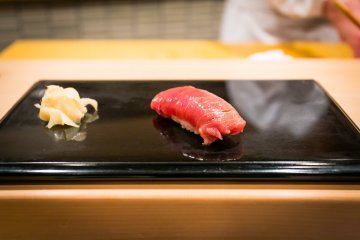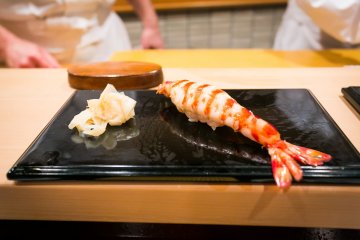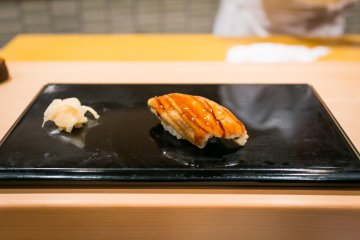A style of eating
It's the current fashion in sushi dining to enjoy this quintessential Japanese dish as course of flavours and textures. Visiting a decent sushi restaurant and ordering the now ubiquitous omakase menu basically means that you are leaving your meal and its makeup in the hands of the chef.
The course decided upon by the chef usually features around ten pieces of sushi served through four courses. In the hands of a master chef these courses are a sublime culinary performance, with each taste harmonising with the next. Granted, not all sushi chefs are masters, but here is what you can expect from a good quality sushi course.
Light and vibrant flavours
Most courses will start with one or two toppings that are delicate and light. Popular choices here include madai sea bream, hirame flounder, suzuki sea bass, kohada gizzard shad, iwashi sardine, and shimesaba vinegared mackerel. The first few toppings are typical shiromi or white-fleshed fish and are known for their delicate flavours. The latter three are shiny-skinned hikari mono fish and can have a very vibrant taste. For these fish to feature so early in the course is very much a display of the chef's skill.

Deep flavours
The next two to three servings will usually be from fish with stronger, deeper flavours. Here, the most common toppings will include akami red-fleshed fish like the famous tuna, including its fattier chutoro and otoro versions. Other popular toppings are katsuo bonito, shima-aji striped jack, kinmedai splendid-alfonsino and mebaru rockfish. At this stage of the course, the chef is likely to be showcasing his or her go to toppings.

Fatty flavours and non-fish
At this stage of the meal, the variety of toppings begins to open up to include non-fish ones. The fattier flavours of fish like salmon, kampachi amberjack, and buri yellowtail are introduced here along with the variety afforded by such toppings as kuruma-ebi tiger prawn, tako octopus, hotate scallop and akagai ark shell. Shellfish fans tend to enjoy this part of the meal.

Unique flavours
The final course in an omakase experience will often end with flavoured toppings that, if strong isn't the word, are certainly unique. At this stage of the meal, toppings like ikura salmon roe, anago sea eel, uni sea urchin, awabi abalone and shako mantis shrimp are quite common. The last dish here will often be a tamagoyaki egg omelette, either served on rice or on its own.

A final word
The skill and sensibility of a chef, the quality of the ingredients and how they are prepared, even the seasons, all play a role in deciding when any sushi topping is served. Trends may change but quality rarely does so whatever is served in your meal - and in whatever order - remember, this is omakase, so leave it up the chef and enjoy the ride.











